Content Warning: Silent Hill: The Short Message contains explicit and continuous themes and references to self-harm, suicide ideation, child neglect, and child abuse. While I won't dwell on these in this review or go into much further detail, please be mindful of this before reading further or, indeed, playing the game yourself.
It's long been known that different Silent Hills wait for different people. For some – most famously perhaps – there are faceless, buxom nurses lurking in the rust-encrusted corridors. For others, flames tower around them, leeching the air of all light and hope. For Anita, sticky notes daubed with crude insults are layered like feathers on every surface. It's kind of beautiful in a dark, melancholic, effected-up way.
Kind of beautiful in a dark, melancholic, effed-up way is actually a pretty good summary for Silent Hill: The Short Message, actually. I went in hopeful, if cautious – I know better than most how many false dawns Silent Hill has had – but by the time I came out the other side just a couple of hours later, I was surprised at not only how I completed The Short Message feels, but how much it affected me, too.
Manage cookie settings
I didn't feel that way halfway through, mind. The Short Message's, well, message, isn't subtle. You play as Anita, a school-aged teen plagued with profound self-esteem issues that manifest in self-harm and suicidal ideation that's inextricably tangled up with the crude, cold approval metrics of social media. Her friend Maya – a graffiti artist of some renown and with a modest social media following – texts to ask if they could meet her at an abandoned apartment block in their town. So off to the abandoned apartment building Anita goes, with nowt but her phone for company. You know. As if she's never seen a horror movie before.
No, the themes here aren't softened by symbolism or metaphor, but TSM has just 90 minutes to convey its story, and given social media does untold damage to people of all ages, maybe someone decided subtlety simply wasn't warranted. There's disappointingly little subtext, though, and with Anita endlessly vomiting up her innermost thoughts aloud or to her pals via text, you're rarely in any doubt as to what she's feeling.
Scratch the surface just a little, however, and you'll discover that the story you think The Short Message is telling you is actually a little more complex than that. What some may write off as vapid teen angst actually frames a broader exploration of love, loss, and the malevolent power of jealousy, as well as the cyclical damage inflicted by generational trauma and abuse. Quite why the team shoehorned its most powerful – and harrowing – subplots into the final act, I have no idea. Nevertheless, it's here that The Short Message blossoms from predictable cliche into something all the more fitting of the psychological horror tagline and, dare I say, a rightful place in Silent Hill canon.



At thirty minutes in, though, as much as I enjoyed exploring the Villa, I found Anita – whilst more authentic and empathetic than most in-game teenagers penned by men in their forties and fifties – a little whiny, her voice performing a little uneven , and her awkward character model jarringly at odds with the sublime and atmospheric environmental design.
Mechanically, it's a little rough, too. I don't care that it's a “walking simulator” – I'm happy to walk anywhere if you've a good story to tell on the way, my friend – nor do I care that The Short Message is so linear, it essentially runs on rails. The full-motion video sequences are both surprising and surprisingly well-executed – with each iteration, Maya's world alters a little – and I enjoy exploring broken, beaten-up spaces as much as I love nosing through old journals and notes to flesh out a story, no matter how twee or unsubtle they are.
I do, however, take great, great umbrage with The Short Message's chase sequences.
Yo hate chases. I hate mazes. Put me in a maze where I'm chased, and I am going to have a bad time of it even if it's the greatest, most thoughtful, most sophisticated chase-maze sequence gaming has ever seen. As I've frequently admitted here, I have no sense of direction in-game or in real life, and the moment you stick a time limit on me or a monster behind me, my system floods with blood-pumping, palm-sweating, humiliating panic.

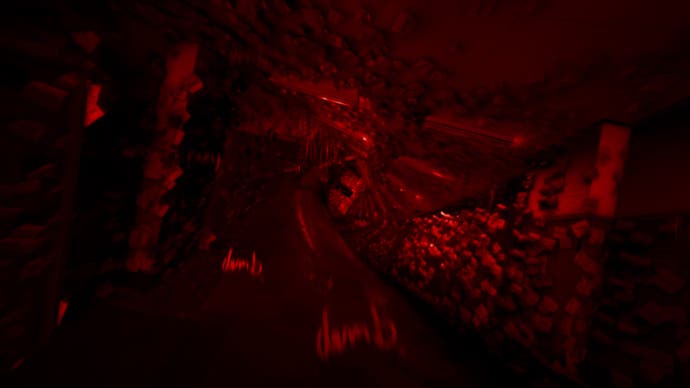

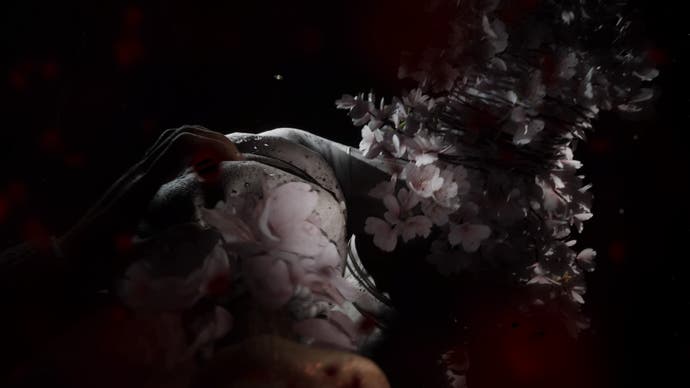
That said, my issue with The Short Message's final chase segment isn't that the maze was too complex (although it was), or too dark (also true), or that it lacked checkpoints (yup) or was too scary (one notable scene aside, little of The Short Message is jumpscare-scary). Yes, I appreciate it symbolizes Anita running from her past. Yes, I understand why the walls are plastered with post-its and photos. My frustration stems from the fact that everything I'd been told about the game's chases so far – run, pick the right door, go the right way, get the hell out – was suddenly meaningless. Three-quarters of the way in, someone changed the rules and didn't even bother to tell me.
We only ever face one enemy in The Short Message's mazes, too, which makes the action segments repetitive at best, and tedious at worst. Yes, it's up there with one of Masahiro “Red Pyramid Thing/Pyramid Head” Ito's most striking designs, and I'll admit that when it was coupled with famed Silent Hill composer Akira Yamaoka's astonishingly unsettling audio, I only ever felt abject terror when I could hear the thing trilling and stomping behind me. It's a shame, though, that we never meet any other worldly denizens carefully crafted by the same troubled psyche, and the clear attention that went into designing the sole antagonist only serves to remind you of how forgettable her human cast looks.
Worse still, this is the first all-new Otherworld Silent Hill fans have had to play in for a decade, but we never get to enjoy it. We never get to explore Item. Instead, all you ever do is run mindlessly through it, desperately trying to get out.
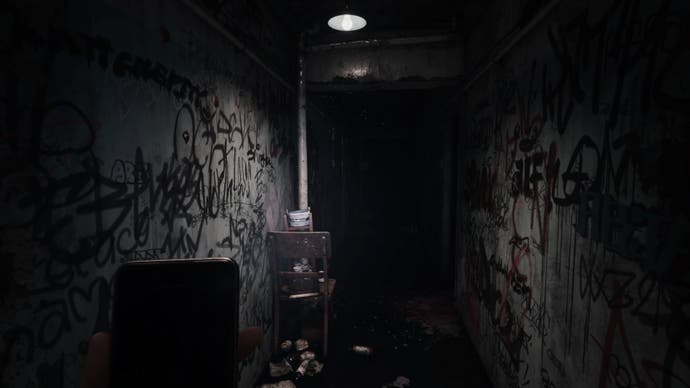
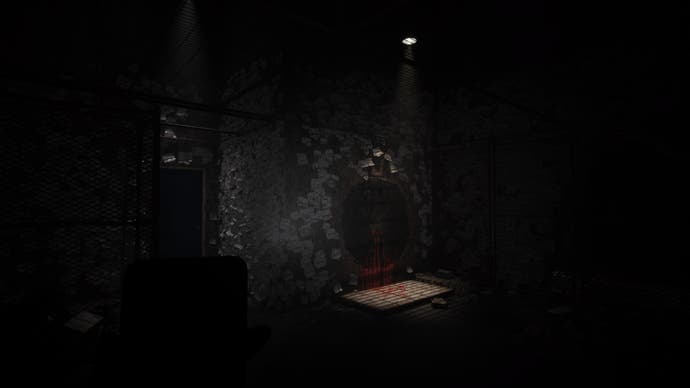
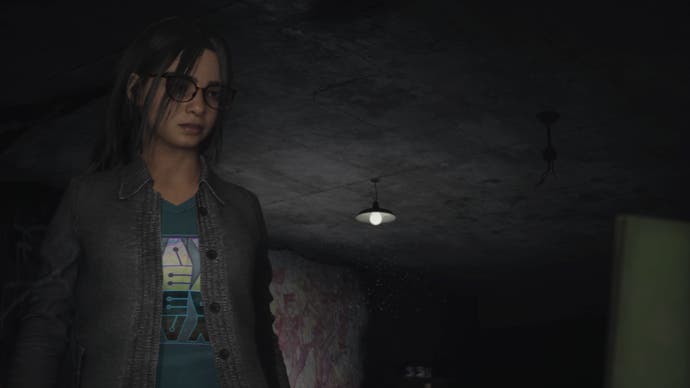
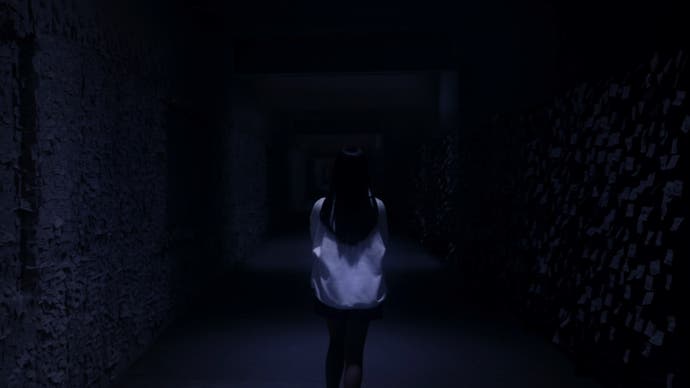
And the game loops, of course. That, too, is a delightful metaphor that makes more sense the more you play. like that other Silent Hill Qlayable Teaser that casts a long, heavy shadow over The Short Message, you'll sometimes notice small, granular details change each time you come through – say, the ominous graffitied hole that grows in front of Anita each time she loops back to it, or the item sitting in the litter bin one of the times you stop by the studio. Other times, it will be shockingly obvious that things are different now… and rarely for the better.
But good grief, there are some truly horrific things secreted through The Short Message for those prepared to look. There's the subtle change of perspective as you move through a curiously familiar living room, for instance, and the scratch marks carved by desperate fingernails on just the lower half of a closet door. You may spot that the visual disturbance that divides in-game cinematics from the full-motion video ones is the same as the static that signals something bad this way comes, or that the peculiarly monochrome world in which Anita visits a friend is peppered with more and more sticky notes every time you see it. Maybe you, too, spotted Maya's beaded bracelet and noticed someone she sketched once wore a similar one, or that she was often drawn to people just like her; flawed, hurt, fragile folk who quietly, and daily, battled their own demons.
The trouble, though, is that truncated run time. In just a couple of hours, The Short Message introduces heavy themes of suicide ideation, teen pregnancy, self-harm, bullying, body dysmorphia, child neglect, child abuse, and even incest, but barely gives you any time to sit with them before introducing the next. Maybe that's why Anita's story made so much more sense after a second playthrough. For its lack of tact and elegance elsewhere, some of TSM's darkest themes are buried beneath layers of intimation and suggestion, but maybe that's intentional (I recall Bloober Team's The Medium made us sit way too long in a painful place where we were supposed to sympathize with a character that absolutely deserved no sympathy). Nonetheless, by stripping just a couple of these out, the story may have been tighter, and the audience better equipped to navigate the darker subplots.
I suspect that anyone who can relate to Anita's fictional experiences from a real-life perspective will have one of two polarizing responses to Silent Hill: The Short Message: deep outrage, or deep admiration. For me – someone who can, unfortunately, relate to some of the darker themes expressed in The Short Message – it's the latter. Despite its inelegant delivery and high-school drama framing, Anita's story, if clumsy at times, is impactful, thoughtful, and – perhaps most importantly of all – hopeful.
No, it may not be the Silent Hill game many of us were expecting; it may not even be the Silent Hill game some people want. But even with that infuriating chase sequence, I'm very glad it exists.
A copy of Silent Hill: The Short Message was independently sourced for review by Eurogamer.
#Silent #Hill #Short #Message #review #powerful #subtle #stoppable